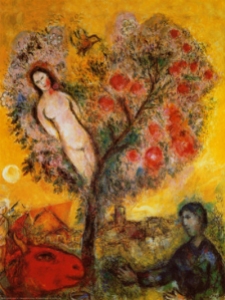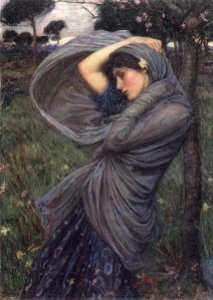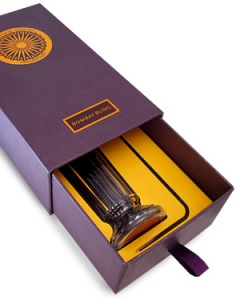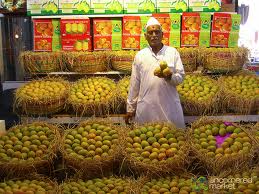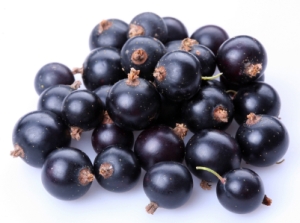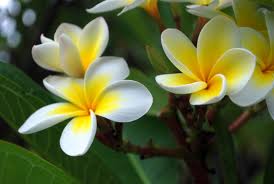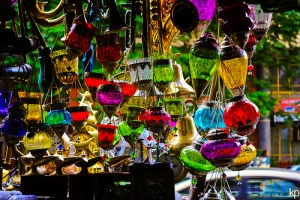A mother’s warm, comforting embrace, holding you close and protectively. A journey into a green wood of peppered vetiver. And a final resting place of creamy sandalwood infused by smoke, ambered resins, and gingerbread vanilla, caressing your skin like the softest of golden veils.
That was my experience with Ashoka, the newest release from Neela Vermeire Créations (“NVC”) which will be released in early Fall of 2013. The perfume was shown at the Milan Esxence show this past March and someone thoughtfully sent me a small vial. The quantity wasn’t enough for my usual two tests, so I may update this review later in the Fall when I obtain a greater sample, especially if it is from a spray. But I certainly had enough for a very thorough test, and I really liked the perfume.
Ashoka is very different from Neela Vermeire‘s existing trio of Trayee, Mohur, and Bombay Bling. For one thing, it has three, very distinct phases. For another, parts of Ashoka represent Comfort for me. If Trayee could be categorized as “Sexy Seductiveness” that can sometimes feel like a wonderful force of nature, Mohur as “Sophisticated, Elegant Femininity,” and Bombay Bling as “Ebullient, Joyful Energy,” then Ashoka is, in large part, “Soothing Comfort.” There is a middle phase where that doesn’t really quite apply, but the perfume as a whole is an easy, wearable, very soothing, relaxing scent.
Ashoka is meant as a tribute to a legendary Indian emperor whose personal history very much matches the perfume’s development. Intentionally so, if I may add. The press release explains both points further:
Inspired by a legendary ruler, Neela Vermeire Création’s new release, Ashoka, is a tribute to an emperor who was conquered by his own compassion at the moment his victory was assured. He converted to Buddhism and devoted the rest of his life to spreading the Buddha’s teachings, to truth, to justice and to compassion for all living creatures beneath the sun.
His own evolution from ruthless conqueror to benevolent emperor is reflected in Ashoka’s journey from the fierce opening to a softly floral heart & the gentle embrace of its richly complex drydown.
Ashoka is an eau de parfum that was created in collaboration with Bertrand Duchaufour. According to an article on Fragrantica, the fragrance underwent numerous formulations to try to achieve a development that matched that of the Emperor himself. Over a year’s worth — until it finally matched Ms. Vermeire’s exacting standards, and the olfactory image she had in her mind of Ashoka’s character and life path. The perfume’s long list of notes includes:
fig leaves, leather, white and pink lotus, mimosa, fig milk, osmanthus, rose, water hyacinth, vetiver, styrax, incense, sandalwood, myrrh, tonka bean, and fir balsam.
I’d read a few things about how Ashoka’s pyramid of notes feels inverted, with the darker, heavier elements being first, starting with leather and green notes, followed by a descent into milkiness. My experience was different, and the usual pyramid scheme seemed solidly in place. In fact, from the very start when I sniffed the perfume vial, there was a lovely bouquet of sweet, milky figs, accompanied by green leaves and a dryly woody note like that of a stem. In essence, it replicated the whole fig on a vine — sweet, fresh, milky, green and woody.
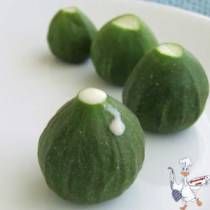
Unripe Figs via Giverecipe.com. (For recipe on Unripe Fig Jam, click on photo. Link embedded within.)
The perfume was a bit different on my skin as Ashoka opens primarily with lactonic notes. It’s fresh, sweet, and supported by what definitely feels like coconut underneath. Fig leaves are said to smell like coconut, and that is certainly the case here. Generally, I’m not a fan of coconut in perfumery because it’s almost invariably blob-like, heavy, gooey, thickly buttered, and verging on Hawaiian suntan oil. But not here where the aroma is much more like coconut milk: fresh, light, delicately sweet, never buttery, or unctuous. It’s a lovely note that helps bolster the fruit’s naturally light aroma and milky sap.
Accompanying the various milky elements is some bitter green, adding balance and ensuring that the perfume is not excessively sweet. The green notes feel like leaves that have the faint vestigial hint of the trees they came from, creating a canopy over the fig and coconut milk. Sweet floral notes lurk behind in the shadows, feeling almost watery in their delicacy. It must be from the lotus flowers which are said to have an aquatic, sweet aroma. I like the contrast of the slightly bitter green leaves with the milky fig and coconut, but I was a little surprised not to get any of the heavy leather that I had read about. Frankly, I think it works better this way.
Five minutes in, Ashoka is a swirling blend of creamy milkiness with dark greenness, and delicate, watery florals. Vetiver and a subtle hint of vanilla arrive on the scene, accompanied by what feels most definitely like a small dash of ISO E Super. The earthy vetiver with the velvety wood accord of the ISO E Super are subtle at this stage, mere backdrops for the milky notes. The latter starts to turn sweeter and more floral; and the bitter leaves begin to fade away.
Ashoka slowly turns into an incredibly soft, soothing bouquet of milky flowers that strongly evokes a mother’s embrace. It feels like a mother’s loving caress when you’re ill and feverish. It’s the sense of comfort that you feel when, as a child, you would nestle in your mother’s arms at bedtime. Ashoka, in this stage, really reminds me of hugging my own mother. Her arms, velvety soft from the milky cream that she slathers herself in at night; the warmth of her body bringing out the light smattering of sweet flowers left on her neck and chest from her morning spray of perfume; the comfort as she holds me close, nestled, protected, and safe. The peppered wood notes underlying Ashoka never really take away from that image because they are just beneath the surface at this point. What is up top is that incredibly maternal, nurturing, comforting combination.
At the end of the first hour, Ashoka starts to slowly shift, and the second phase in the perfume’s development begins. The wood and ISO E Super rise in prominence, overtaking the lactonic elements which slowly recede to the background. Now, Ashoka is primarily heavily peppered vetiver with ISO E Super on a quiet base of coconut-fig milk. It’s as if your mother — or, in this case, Father Ashoka — has taken you to play outside amidst the grassy vetiver at the outskirts of some peppered woods.
The ISO E Super is not overwhelming and never has the feel of rubbing alcohol underneath it, as it sometimes does. Unfortunately, after an experience last month, I think I have almost a Pavlovian response to the note, and I react even if the bell is the smallest one around. The faintest ring — or, in this case, the lightest note — will send my senses tingling. I simply don’t like it. Yes, I realise that prior experience has scarred me for life, but that is solely my own, personal, slightly neurotic issue. Thankfully for the rest of you, most people seem to be completely anosmic to ISO E Super which has been found, in some cases, to act almost like an aphrodisiac pheromone. So the majority of you should have no worries, and only those few people with acute sensitivities to ISO E Super may want to take heed.
At the start of the third hour, my favorite part of all NVC perfumes begins: the sandalwood. As always, it is that opulently creamy, richly spiced note that feels like real Mysore sandalwood and which is the hallmark of all the fragrances thus far. The wood is so rare, it might as well be priceless, so heavens only knows how astronomical the cost to have it as the base here. But it’s lovely, especially as the milky coconut-fig accord melds in seamlessly to add extra creaminess. The spicy sandalwood is accompanied by quiet hints of incense smoke, vanilla tonka and amber, but they are subtle at this stage, just flickers in the campfire glow of that wood. I smell a few vague, almost abstract, light florals too; something that seems like the suggestion of rose, accompanied by mimosa, but it’s not strong on my skin. The peppered vetiver is still present, but it has softened somewhat, letting the other players share some time on the stage. I should add that the combination of these notes makes Ashoka a definite Oriental in my mind, regardless of Fragrantica’s classification of it as a “woody aromatic.”
The rich purr of the sandalwood and the peppered woodsy notes with amber continue their dance for a few hours. There are occasional flickers of osmanthus, smelling like light apricots and black tea, but it’s extremely subtle. There is also a fleeting impression of powdered vanilla that darts about here or there, but it might as well be a ghost at this stage. I never smell the leather. I suspect that, if I had enough perfume for the equivalent of two big sprays, it may be a very different story. I’ve noticed in the past that it’s much easier to detect the subtle nuances in NVC perfumes if one uses both a spray and a fair portion. The fragrances are simply too well-blended to allow the small, microscopic elements to be detected with a small dose, since everything blends so seamlessly into each other. Still, I’m surprised to get no leather at all, especially as that it’s a heavier molecule and one which is supposed to be quite prominent in the perfume. The leather is intentionally meant to reflect Emperor Ashoka’s early life as a cruel, ruthless, military conqueror, so either my skin is wonky or I need a good few sprays.
By the start of the sixth hour, Ashoka smells of a cozy gingerbread accord with vanilla — all sitting atop quiet, velvety, softly polished woods. The perfume has the same sort of subtly spiced, vanilla-infused, ambery resin base that some of the Chanel Orientals have (like Bois des Iles, for example), but the lingering traces of ISO E Super turns Ashoka’s base into something much woodier and, to my nose, peppery. By the very end, almost 10.5 hours later, the final notes are of creamy vanillic amber. I suspect that length of time would be significantly increased if I had a greater amount to apply, as NVC fragrances usually last between 12-14 hours on my perfume-consuming skin.
As a whole, Ashoka is a very airy fragrance that is moderately strong at the start, while being lightweight in feel. Its projection is moderate to low. The latter may stem from the reduced quantity that I used but, in general, I think Ashoka is fully intended to be a softer, lighter perfume than something like Trayee or Bombay Bling. It is in line with the whole goal of replicating Emperor Ashoka’s transformation into an advocate of Buddhism, peace, and serenity. The perfume’s comforting, soothing, maternal (sorry, this perfume simply doesn’t fit my mental associations and image of a paternal scent) opening was strong but gentle, never forceful or overpowering, and its final drydown is even softer.
I think all that makes Ashoka an easier fragrance in some ways as compared to its more intense siblings. It’s not that Trayee, Mohur or Bombay Bling are not versatile. They are, especially Mohur. But none of them is so gentle, soft, and casual. As I noted at the top of this review, Ashoka fills a gap in the NVC line, one that I never realised until now: cozy comfort. Bombay Bling may comfort a lot of people, but it does so through its energizing, ebullient nature. It’s not restful, the way that Ashoka is for much of its development. (I’m leaving out the middle part’s trip to the vetiver forest in my assessment, since I personally don’t equate vetiver with soothing embraces.)
I really enjoyed Ashoka. I absolutely adored the milkiness of the opening stage, and really liked the final drydown. My personal issues with ISO E Super made me struggle with the middle part, but that’s my own peculiarity. Most people I know can’t even detect it! So, don’t let it stop you. I think Ashoka’s creamy gentleness and soft embrace will make it a big, big hit.
[ED. Note: You can find a review for the new, upcoming Neela Vermeire “Mohur Esprit” which will come out at the same time as Ashoka here.]







